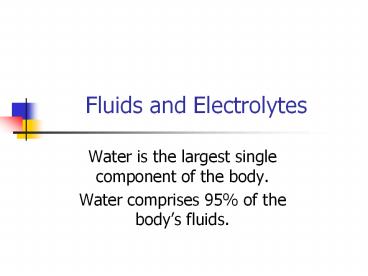Fluids and Electrolytes PowerPoint PPT Presentation
Title: Fluids and Electrolytes
1
Fluids and Electrolytes
- Water is the largest single component of the
body. - Water comprises 95 of the bodys fluids.
2
Water content varies
- Infant 70 water
- Males 60 water
- Females 50 water
- Elderly 45 water
- Muscle 65 water
- Fat 20 water
3
Intake equals Output
- Intake (2500ml)
- preformed ingested water (60,30)
- metabolic water (10)
- Output (2500ml)
- urine, feces
- sweat, evaporation
- Regulated by aldosterone and ADH
4
Water Compartments
- Intracellular compartments
- 2/3 of total water volume
- Extracellular compartments
- 1/3 of water volume
- Movement between regions by filtration and
osmosis
5
Electrolytes
- Acids, Bases and Salts
- Substances that dissolve in water, conduct
electricity and dissociate into ions
6
Acid-Bases Balance
- pH - log H
- pH 7.0 is neutral
- Normal range is 7.35-7.45
- Control mechanisms
- Kidneys
- Respiratory System
- Buffers
7
Buffers
- Carbonic Acid/Bicarbonate system major regulator
of extracellular pH - HCO3- functions as weak base
- H2CO3 functions as weak acid
- Work by converting a strong acid/base to a weaker
one
8
Phosphate Buffer System
- Similar to that of the bicarbonate system
- Important urine and intracellular buffer
- Component parts
- NaH2PO4 acts as a weak acid
- Na2HPO4 acts as a weak base
9
Protein Buffer System
- Most abundant buffering system in the body
including intracellular and extracellular
compartments - Carboxyl groups (COOH) and amine groups (NH3) act
as either an acid or a base
10
Acid - Base Imbalance
- Acidosis (pHlt7.35)
- Alkalosis (pHgt7.45)
11
Respiratory Acidosis or Alkalosis
- Results from an imbalance of CO2
- Respiratory Acidosis - due to increase of CO2
- decreased respiration results in
- ? CO2 ? ?H ? ?pH
- Respiratory Alkalosis - decrease of CO2
- increased respiration or hyperventilation
- ?CO2 ? ?H ??pH
- CO2 H2O ? H2CO3 ? H HCO3-
12
Metabolic Acidosis or Alkalosis
- Results from imbalance of HCO3-
- Metabolic acidosis - due to decrease of HCO3, ,
which lowers pH - excessive alcohol, prolonged diarrhea, renal
dysfunction - Metabolic alkalosis - due to increase of HCO3,
which increases pH - excessive vomiting
PowerShow.com is a leading presentation sharing website. It has millions of presentations already uploaded and available with 1,000s more being uploaded by its users every day. Whatever your area of interest, here you’ll be able to find and view presentations you’ll love and possibly download. And, best of all, it is completely free and easy to use.
You might even have a presentation you’d like to share with others. If so, just upload it to PowerShow.com. We’ll convert it to an HTML5 slideshow that includes all the media types you’ve already added: audio, video, music, pictures, animations and transition effects. Then you can share it with your target audience as well as PowerShow.com’s millions of monthly visitors. And, again, it’s all free.
About the Developers
PowerShow.com is brought to you by CrystalGraphics, the award-winning developer and market-leading publisher of rich-media enhancement products for presentations. Our product offerings include millions of PowerPoint templates, diagrams, animated 3D characters and more.

